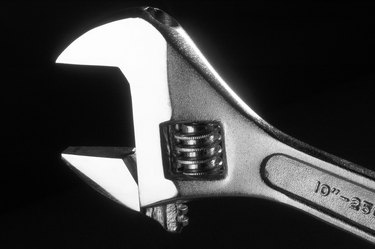Things You'll Need
Adjustable wrench
Vise grip wrench
Flat-tip screwdriver
Cross-tip screwdriver

So you live in an apartment with low water pressure. You're thinking, "If I just knew how to increase the water pressure, I could save a few minutes in the shower when I'm trying to rinse." Knowing how to increase apartment water pressure will also save you time when washing and rinsing dishes in a kitchen sink. In the end, your efforts to increase the water pressure may prove futile; however, one thing just may do the trick. Check and see if the flow restrictor is clogged.
Kitchen and Bathroom Sink
Step 1
Either by hand, an adjustable wrench or a vise-grip wrench, unscrew the flow restrictor on the end of your bathroom or kitchen sink faucet, along with any rubber gaskets with it. The flow restrictor is simply the aerator (screen) where the water exits at the end of the faucet.
Video of the Day
Step 2
Inspect the screen for any clogs. Clean any clogs that may be present.
Step 3
Run both the hot and cold water at a high rate for a minute or more. Sometimes debris that is too large to pass through the aerator (screen), or flow restrictor, stays trapped in the plumbing near the faucet, and only moves back and forth between the screen and back to where it rests when the water is turned on and off.
Step 4
Replace the flow restrictor. Test the water pressure.
Shower Head
Step 1
Remove the shower head by unscrewing it by hand or with a wrench from the pipe extension protruding from the wall. Disassemble the shower head, remembering how you take it apart so that you can put it back together the same way you took it apart.
Step 2
Inspect the shower head for any clogs. Clean clogs, if necessary.
Step 3
Run both the hot and cold water at a high volume flow. Again, this is to clear out any foreign debris that may be lodged somewhere in the plumbing. Because such debris can't pass through the shower head, it can decrease the water pressure.
Step 4
Reassemble the shower head and re-attach it to the pipe extension. Test the water pressure.
Video of the Day